Tech, TEK and Tea: Difference between revisions
No edit summary |
|||
| (5 intermediate revisions by the same user not shown) | |||
| Line 1: | Line 1: | ||
[[File:Ice pressure ridge background (sm).png|thumb]] | |||
Significant technical interventions were required to conduct and live-stream Coral Harbour TEK interviews in a way that followed local Covid-19 protocols, and allowed southern BearWatch team members to participate remotely. | |||
=Making Participation Happen= | |||
A mounted phone, a large table-stand microphone and two go-pro cameras, of which one mounted on a structure that was built over the dining table to film the mapping exercise that was part of the interview, were required to respectively live-stream the go-pro recording, a conference call and to also record high-quality audio. | |||
Other materials required for these interviews included a large paper map of Southampton Island, an acetate sheet and waterproof markers in front of the interviewee, and a piece of paper to mark specific timestamps in front of the interviewer. | |||
This was in addition to another phone mounted on a tripod elsewhere in the room to record an offline version of the interview- and of course, the masks, handsanitizers, and informed consent sheets. | |||
[[File:Tech distanced observer.jpg|thumb|The material wreckage required to facilitate remote participation.]] | |||
=Piloting Remote Interview Technologies= | =Piloting Remote Interview Technologies= | ||
| Line 21: | Line 27: | ||
The go-pro livestream recording of the map was “choppy” during this first interview and hard to follow due to poor internet connection. | The go-pro livestream recording of the map was “choppy” during this first interview and hard to follow due to poor internet connection. | ||
This, in combination with the use of Inuktitut, resulted in much feedback and questions from the Southern researchers that were attempting to follow and participate with the interview remotely across different channels. In turn, | This, in combination with the use of Inuktitut, resulted in much feedback and questions from the Southern researchers that were attempting to follow and participate with the interview remotely across different channels. In turn, requiring physical interference from the research assistant in the room, who was also attending to multiple battery, and storage functionalities. | ||
These disruptions, in combination with the material realities of adhering to Covid-19 protocols in the form of wearing masks and physical distancing proved enough reason for Leonard to pause and change course halfway the interview. | These disruptions, in combination with the material realities of adhering to Covid-19 protocols in the form of wearing masks and physical distancing proved enough reason for Leonard to pause and change course halfway the interview. | ||
Latest revision as of 15:43, 18 July 2025

Significant technical interventions were required to conduct and live-stream Coral Harbour TEK interviews in a way that followed local Covid-19 protocols, and allowed southern BearWatch team members to participate remotely.
Making Participation Happen[edit]
A mounted phone, a large table-stand microphone and two go-pro cameras, of which one mounted on a structure that was built over the dining table to film the mapping exercise that was part of the interview, were required to respectively live-stream the go-pro recording, a conference call and to also record high-quality audio.
Other materials required for these interviews included a large paper map of Southampton Island, an acetate sheet and waterproof markers in front of the interviewee, and a piece of paper to mark specific timestamps in front of the interviewer.
This was in addition to another phone mounted on a tripod elsewhere in the room to record an offline version of the interview- and of course, the masks, handsanitizers, and informed consent sheets.

Piloting Remote Interview Technologies[edit]
The interviews were conducted at a large dining table in Leonard Netser’s living room, which provided for the required distancing between “interviewer” and “interviewee”.
A third, locally hired research assistant, was also present in the room to attend to several recording devices, streaming platforms, battery levels and communication channels. All three people present in the room were masked and physically distancing from each other.
After a successful technical pilot, in which Leonard was interviewed remotely by multiple Bearwatch researcher on the basis of a collaboratively designed semi-structured interview guide, we proceeded with the first formal interview.
This interview, was to be conducted in Inuktitut by Leonard, with several moments of summary in English during the interview, and more elaborate translation of marked timestamps afterwards. This decision was made in response to the fact that the interviewee did not speak English.
Disruptive Dynamics[edit]
The go-pro livestream recording of the map was “choppy” during this first interview and hard to follow due to poor internet connection.
This, in combination with the use of Inuktitut, resulted in much feedback and questions from the Southern researchers that were attempting to follow and participate with the interview remotely across different channels. In turn, requiring physical interference from the research assistant in the room, who was also attending to multiple battery, and storage functionalities.
These disruptions, in combination with the material realities of adhering to Covid-19 protocols in the form of wearing masks and physical distancing proved enough reason for Leonard to pause and change course halfway the interview.
Tea for Tech[edit]
He suggested, after about an hour, to finish the interview with a cup of tea, and without the presence of the Southern researchers.
The stark contrast between a packing list of 20 items, to facilitate the participatory presence of Southern researchers, seemingly required to conduct these TEK interviews- and the continuation of the interview with one cup of tea, and one recording device- begs the question of how all those bodies matter, and whether they matter at all.
